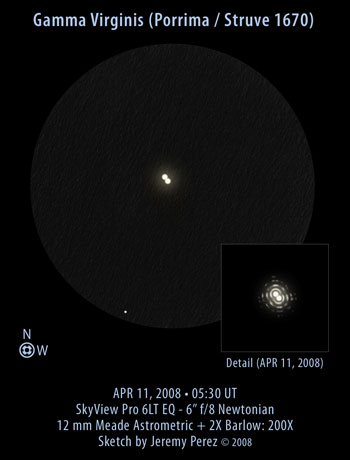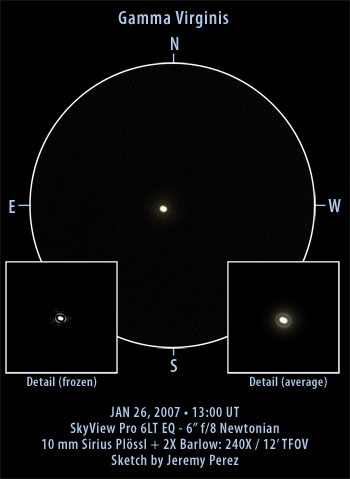
Move mouse over sketch above to see comparison detail illustration from January 2007. Click the image for a larger version.
About 38 light years away in the constellation Virgo, this pair of twin stars orbit one another once every 169 years. When I last observed them in January 2007, they appeared as a single, elongated, pill-shaped star. Last week, April 10, 2008, the diffraction discs were now clearly separated into two distinct stars with no overlap. Position angle had also proceeded about twenty degrees clockwise since my last look.
During my January 2007 observation, I estimated a position angle of 60 degrees. However, the data in Brian Workman's Double Star calculator indicated they should have been 49 degrees. I thought this was strange at the time, since I would probably have guessed 45 degrees if that were the case. Recently, I had a look at some more refined data provided by Brian Skiff. Plugging that into the calculator led to January 2007 value of 58 degrees--much closer to my estimate at the time.
For the April 10, 2008 observation, I was able to put the astrometric eyepiece to use on the pair, and arrived at a position angle of 36 degrees. Skiff's data points to a value of 37.9 degrees. Based on diffraction discs that are not quite touching, I estimated a separation of .92 arc seconds. Skiff's data comes out to .993 arc seconds.
I was excited to see such a pronounced difference since last year. What a privilege to watch the slow dance of this stellar couple.
| Subject | Gamma Virginis (Porrima / STF 1670) |
| Classification | Double Star |
| Position (J2000) | Virgo [RA: 12:41:39.9 / Dec: -01:26:58]* |
| Position Angle* | 36° [My measurement 2008.27] 37.9° [Skiff Data interpolated 2008.27] |
| Separation* | 0.92" [My measurement 2008.27] 0.993" [Skiff Data interpolated 2008.27] |
| Magnitudes* | 3.6; 3.7 |
| Spectral Types* | - |
| Date/Time | APR 10, 2008 - 10:30 PM MST (APR 11, 2008 - 05:30 UT) |
| Observing Loc. | Flagstaff, AZ - Home |
| Instrument | Orion SVP 6LT Reflector (150 mm dia./1200 mm F/L) |
| Eyepieces/Mag. | 12 mm Meade Astrometric Eyepiece+ 2X Barlow (200X) |
| Conditions | Clear, calm, first quarter moon |
| Seeing | 6/10 Pickering |
| Transparency | NELM Mag ~5.0 |
| References | The Washington Visual Double Star Catalog, 1996.0 (Worley+, 1996); Brian Workman's Double Star Calculator (Using orbital elements supplied by Brian Skiff) |
JANUARY 26, 2007 Observation

Click above image for larger version
Observation Notes:
You'll be taking a dose of your stellar medicine if you observe Gamma Virginis with a 15 cm scope. This close double star appeared pill shaped in my 6 inch reflector. The seeing was great, and the clear, buzzing diffraction rings made for a beautiful impression of this elongated pair. I didn't see any indentation or peanut shape. Coloration was a subtle ivory. The axis elongation appeared to have a position angle of either 60 or 240 degrees depending on which star was the primary. Running the double star's orbital data through Brian Workman's Double Star Calculator gives a PA for January 2007 of 49 degrees with a separation of .75 arc seconds.
The sketch here is a bit different than usual. I have the normal eyepiece circle view, which in this case doesn't serve much purpose other than consistency with my other double sketches. I also include the detail sketch on the lower right that indicates the elongated shape with typified diffraction ring position. What I've added that is new, is a 'frozen' detail sketch in the lower left that gives a snapshot impression of what the diffraction rings and diffraction disc looked like to my eye. You may want to click the image for a larger version to better see this.
| Position Angle* | 60° [My estimate 2007.07] 58° [Skiff ephemeris 2007.07] |
| Separation* | 0.67" [Skiff ephemeris 2007.07] |
| Date/Time | JAN 26, 2007 - 06:00 AM MST (JAN 26, 2007 - 13:00 UT) |
| Observing Loc. | Flagstaff, AZ - Home |
| Instrument | Orion SVP 6LT Reflector (150 mm dia./1200 mm F/L) |
| Eyepieces/Mag. | 10 mm + 2X Barlow (240X) |
| Conditions | Clear, calm, 18° F |
| Seeing | 6/10 Pickering |
| Transparency | NELM Mag ~5.8 |
| References | The Washington Visual Double Star Catalog, 1996.0 (Worley+, 1996); Brian Workman's Double Star Calculator (Sixth Catalog of Orbits of Visual Binary Stars by William I. Hartkopf & Brian D. Mason) |





Jeremy, this is a nice collection of double star sketches you've got here - someone's been getting up early! Nice job in particular on notching the gradually widening binary star Porrima! This is the first double star I remember seeing through a telescope - of course it was a much easier target in 1981! :)
Cheers!
Eric
Oh boy, morning is definitely not my time! Normally I would have waited a few months before giving them a shot. But James Mullaney has another double star article coming out in the May issue of Sky & Telescope, and I wanted to give them sketches of all 25 stars he describes in the article so they can pick the ones they want. These were the last few on the list and the clock was ticking. I'm glad I got to see them though. It's a really nice selection he's writing about.
I was worried about Porrima/Gamma VIR. I knew it was going to be a close one. It's a great feeling to line it up under good seeing conditions and be able to discern that slightly elongated dot. It's an even better feeling to look up the stats afterward and see that the sketched elongation was pointing in the expected direction.
Wait til you see the Pi LUP observation I made the same morning. What a mess that observation was.
Thanks for the post! I hope you get a chance to grab another look at Porrima through your scope as it approaches the 'peanut' stage.
Jeremy
Excellent! I've enjoyed the three (?) double star articles Mr. Mullaney has written so far. I this upcoming article going to be the last in the series or will there be more of them?
Pi Lupi (goofy name - but not as bad as variable star RU Lupi) looks fantastic. I've viewed way too many double stars that look very much like the leftmost inset in that observation - thank goodness for occasional moments of decent seeing conditions.
Eric
"RU Lupi", awesome! Thanks for the laugh. :D Latin genitives are great. I think this will be the last in the double star series he is writing for S&T(for a total of 4 seasons' worth of doubles).
Yeah, that Pi Lupi observation was like looking at fried eggs (over easy) with lots of grease spattering so you can't get a good long look at where the yolks are hiding.
Jeremy
Hello Jeremy,
I just observed Gamma Virginis from my backyard (April 2nd 2009 ~ 0730 UT) in Queen Creek, AZ. The seeing condition here was pretty average (approximately 2.5/5 from my estimate). The observation was made using both an 8" f4.5 and a 10"f7 and I could tell there's elongation from the star images in the North-South orientation.
I was wondering whether you have a recent observation or know of any recent observations for comparison. I would estimate the separation to be around 1", this without any precise equipment and by doing a visual comparison with Algieba (gamma Leonis). Thanks!
PS: I always enjoy your drawings! Wish I had your patience!
Derrick
Hi Derrick,
I'm sorry I didn't reply sooner. I do have a more recent observation from last month. I haven't had a chance to update this entry yet. I measured 33 degrees on Feb 20, 2009. The current ephemeris shows it should have been 29.7 degrees on that date. So it is closing in on a north-south alignment. There is a recent discussion at CloudyNights.com about the latest observations and data on this very nice binary. I hope that helps a bit. Thanks for sharing your observation!
Jeremy
Hello Jeremy,
Thank you for the reply and information on the double. At least now I do know I wasn't imagining the elongation! :-)
Thanks!
PS: I really enjoy your astro sketches and use them a lot to compare with my observations :-)
Derrick
Hi Derrick, you're welcome, and it's my pleasure. I do much the same--comparing my sketches to those of other observers. It's always fascinating to see the similarities and the differences.